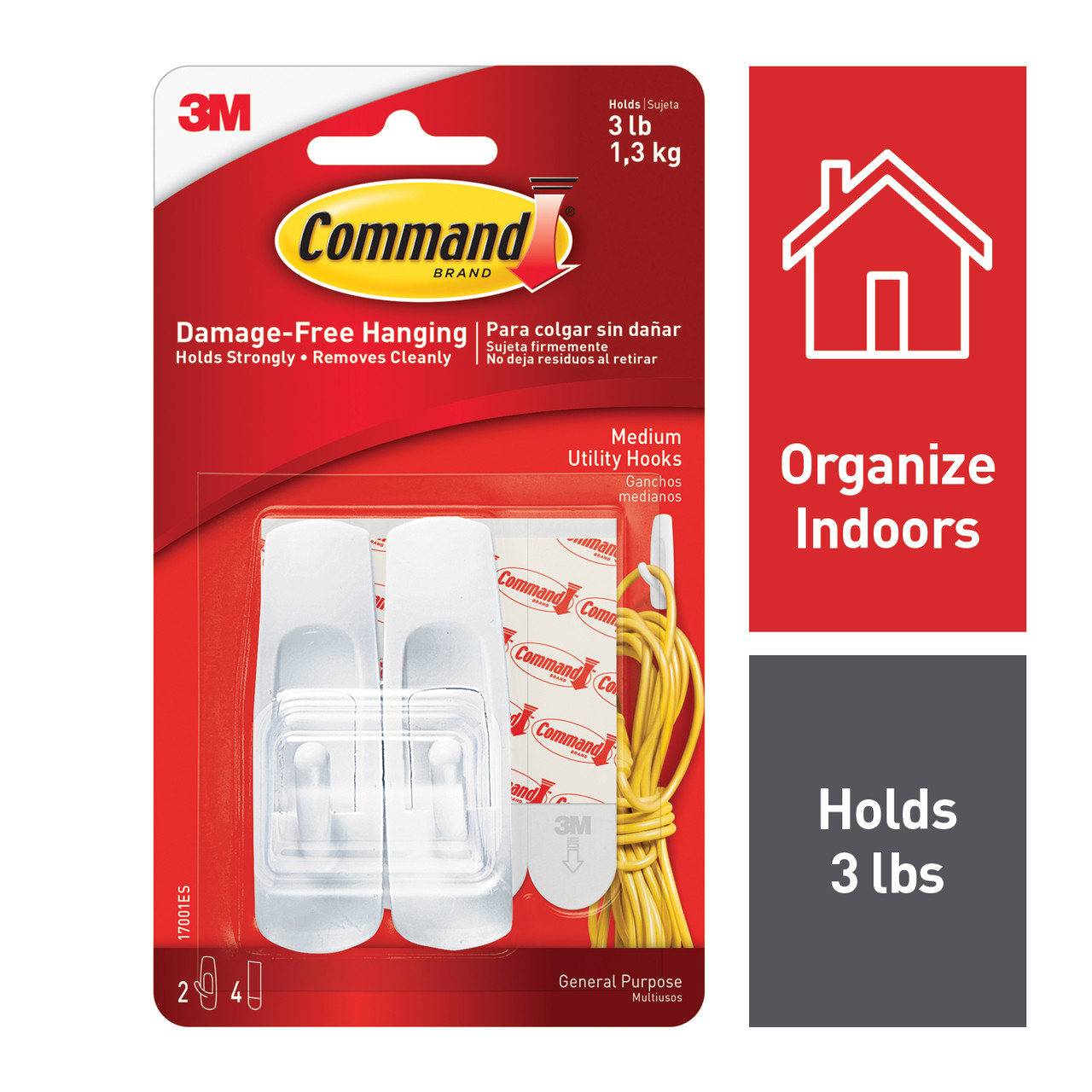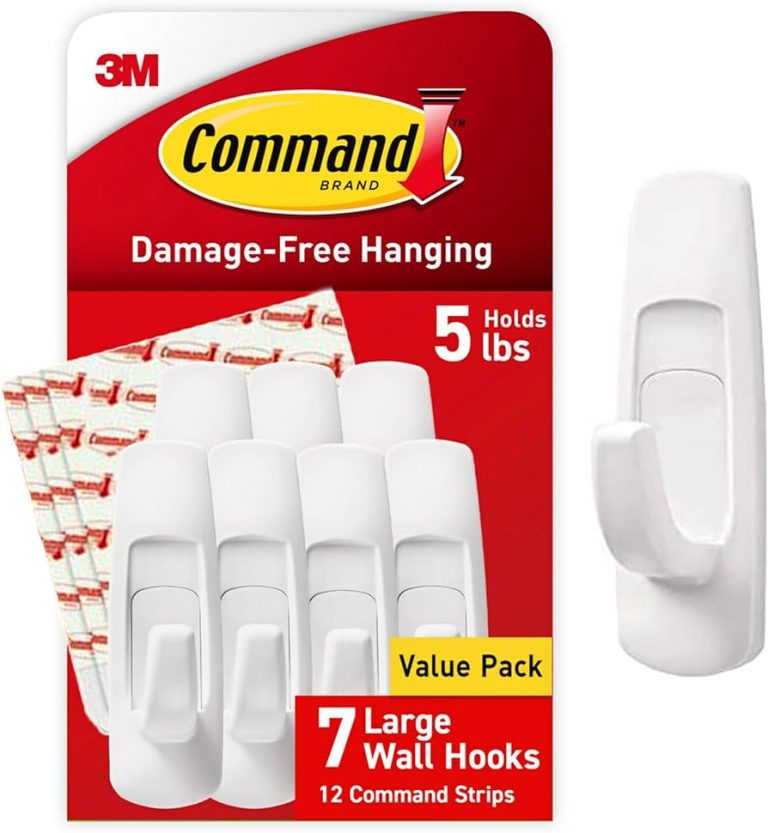When it comes to organizing and decorating your living space, the right tools can make all the difference. You’ve probably heard about command hooks and utility hooks, but do you really know which one is the best fit for your needs?
Choosing between these two popular options might seem straightforward, but the decision can impact your home’s aesthetics and functionality more than you might expect. Imagine a clutter-free environment where everything has its place and you can easily change things up without hassle.
Sounds appealing, right? This article will guide you through the advantages and limitations of command hooks versus utility hooks, helping you make an informed choice that suits your unique situation. Whether you’re hanging a picture frame, organizing your kitchen, or simply trying to keep your office tidy, understanding the differences can save you time and frustration. Dive in to discover how these hooks can transform your space and streamline your life.
Features Of Command Hooks
Command Hooks have become popular for home and office organization. They offer a simple and effective way to hang items without tools. These hooks are versatile and cater to various needs. Their features make them a reliable choice for many users.
Easy Installation
Command Hooks are easy to install on most surfaces. You don’t need drills or screws. Just peel the backing and press the hook onto the wall. This process is quick and hassle-free. Even kids can help with the setup.
Strong Adhesive
These hooks use a strong adhesive to hold items securely. The adhesive can support a range of weights. They are suitable for light to medium items. You can trust them for keys, hats, or small kitchen tools.
No Damage
Removing Command Hooks won’t damage your walls. The adhesive leaves no residue behind. This feature keeps your walls clean and intact. It’s perfect for renters or people who like to rearrange often.
Variety of Sizes and Styles
Command Hooks come in various sizes and styles. This variety means you can choose the perfect hook for your needs. Whether you need small hooks for keys or large ones for coats, there’s an option available.
Weather Resistance
Some Command Hooks are designed for outdoor use. They can withstand rain, heat, and cold. This makes them ideal for hanging decorations outside. You can decorate your porch or patio without worry.
Reusable
These hooks can be reused with new adhesive strips. You can move them from one spot to another. This feature adds value and flexibility to your purchase. It’s a smart choice for changing needs or spaces.
Features Of Utility Hooks
Utility hooks are versatile, designed to hold various items like tools or kitchen utensils. Unlike command hooks, utility hooks offer more durability and can handle heavier loads. They are perfect for organizing garages or workspaces efficiently.
When it comes to organizing your space, choosing the right hooks can make a big difference. Utility hooks are versatile tools that can help you hang items securely and efficiently. These hooks offer unique features that make them stand out from other options like Command Hooks. Whether you’re looking to tidy up your kitchen, garage, or office, understanding the features of utility hooks can help you make the best decision for your needs. ###Durability
Utility hooks are known for their strength and long-lasting nature. Made from robust materials like stainless steel or heavy-duty plastic, they can support heavier items. Unlike some hooks that might snap under pressure, utility hooks provide a reliable solution for hanging tools, bags, and even bikes. ###Versatility
Do you have various items to hang? Utility hooks can handle them all. They come in different sizes and styles, which means you can use them for anything from hanging your garden tools to organizing your kitchen utensils. Their adaptability makes them a go-to choice for those who need flexibility. ### Nobody wants to spend hours installing hooks. Utility hooks often feature straightforward installation processes. Many can be easily screwed into the wall, requiring minimal effort and tools. This makes them a practical choice for quick setups. ###Load Capacity
Have you ever worried about a hook failing under weight? Utility hooks boast impressive load capacities, often supporting several pounds. This feature is especially useful in garages or workshops where heavy equipment needs to be hung securely. You can trust these hooks to hold your items without concern. ###Cost-effectiveness
Balancing quality with budget is important. Utility hooks offer a cost-effective solution without sacrificing performance. You don’t have to break the bank to get reliable hooks that serve your purpose well. This makes them an attractive option for both personal and professional use. ###Customizability
Do you like having options? Utility hooks often come in various shapes and configurations. This allows you to tailor them to your specific needs. Whether you need a hook for a specific tool or want to create an organized layout, these hooks provide the flexibility you desire. ###Space Optimization
Utility hooks can transform how you use your space. By organizing items on walls, you free up floor space. This leads to a cleaner, more efficient environment. It’s a simple yet effective way to enhance the functionality of your home or workspace. If you’re looking to declutter and optimize, utility hooks offer practical solutions that can make a tangible difference. Have you tried using utility hooks before? What challenges have you faced in organizing your space? Your answers might just lead you to discover the perfect hook for your needs.Material Composition
The material composition of hooks determines their durability and strength. Choosing the right hook depends on what you want to hang. Let’s explore the different materials used in Command Hooks and Utility Hooks.
Command Hooks: Plastic And Adhesive
Command Hooks often use plastic materials. This makes them lightweight. The adhesive back sticks to surfaces without damage. They are suitable for light items. Think of them for pictures and small decorations.
Utility Hooks: Metal And Screws
Utility Hooks usually consist of metal. This includes options like steel and brass. They provide a sturdy hold for heavier items. Perfect for tools, pans, or bikes. Metal hooks often need screws for installation. This adds more strength and stability.

Credit: www.amazon.com
Weight Capacity
Command hooks offer varied weight capacities, perfect for lightweight items. Utility hooks handle heavier objects, providing sturdier support. Choosing between them depends on what you need to hang.
When deciding between Command Hooks and Utility Hooks, understanding their weight capacity is crucial. This factor can be a game-changer, especially when you want to hang heavier items. If you’ve ever had a hook fail on you, leaving a picture frame shattered on the floor, you know the importance of choosing wisely. Let’s dive into the specifics of weight capacity for these hooks and ensure you make the best choice for your needs.Command Hooks: Lightweight Champions
Command Hooks are known for their versatility and ease of use. They typically come with a weight capacity ranging from 0.5 pounds to 7.5 pounds. This makes them perfect for hanging lightweight items like small picture frames, calendars, or decorative items. I’ve used Command Hooks in my home office for organizing cables, and they’ve held up well. However, it’s crucial to adhere to the weight limits specified on the packaging. Exceeding these limits could result in the hook peeling off, possibly damaging your wall or items.Utility Hooks: The Heavy Lifters
For heavier items, Utility Hooks are your go-to option. They can support weights ranging from 10 pounds to over 50 pounds, depending on the size and type of the hook. This makes them ideal for hanging larger items like heavy mirrors, shelves, or even bicycles. In my garage, I’ve used Utility Hooks to store garden tools and sports equipment. They’ve proven to be reliable over time. However, it’s important to ensure the hooks are securely fastened to a stud or solid surface to maintain their strength.Choosing The Right Hook For Your Needs
How do you decide which hook to use? Start by assessing the weight of the items you plan to hang. Consider whether they will be in a high-traffic area where they might be bumped. If you’re hanging a valuable or fragile item, err on the side of caution with a stronger hook. Think about the surface you’ll attach the hook to. Some surfaces, like drywall, may not support heavier weights without additional reinforcement. Understanding these details will help you choose the right hook, ensuring your belongings stay securely in place. Would you trust a lightweight hook with your valuable items? Making an informed decision about weight capacity can save you from potential mishaps and give you peace of mind.Ease Of Installation
Choosing between Command Hooks and Utility Hooks often boils down to ease of installation. Both options offer unique advantages, making it crucial to understand their installation processes. This can save time and avoid frustration.
Command Hooks: Simple And Quick Setup
Command Hooks are known for their simplicity. Peel off the adhesive backing and press it onto a clean surface. No tools are needed, making it perfect for quick setups. These hooks work well on many surfaces like walls and doors. Ensure the surface is dry before attaching. This prevents the adhesive from failing.
Utility Hooks: Traditional Installation Process
Utility Hooks may require tools for installation. Screws or nails are common with these hooks. This traditional method ensures a strong hold. It may take more time than Command Hooks. But it provides reliability for heavier items. Ensure you have the right tools handy. A screwdriver or hammer is often needed.
Installation Time Comparison
Command Hooks are faster to install. They save time with their peel-and-stick method. Utility Hooks take longer due to tool requirements. Consider the time factor when choosing between them. Quick installations suit busy lifestyles.
Command Hooks work on smooth surfaces. They are ideal for painted walls and glass. Utility Hooks adapt to textured surfaces. Wood and concrete are suitable for them. Choose based on your surface type. This ensures better results.

Credit: www.itapestore.com
Durability Factors
Choosing the right hook for your needs can be challenging. Understanding durability factors is key. Command Hooks and Utility Hooks offer different strengths. Let’s explore their durability aspects to help you decide.
Material Composition
Command Hooks are made from plastic and adhesive strips. These materials offer moderate strength. They are suitable for lighter items. Utility Hooks, on the other hand, are often metal. Metal provides more durability and strength. Ideal for heavier objects.
Weight Capacity
Command Hooks support lighter weights, usually up to 5 pounds. This makes them great for small picture frames. Utility Hooks can handle more weight. Some can support up to 50 pounds. Perfect for tools or heavier decor.
Environmental Resistance
Command Hooks are not water-resistant. Moisture can weaken their adhesive. They work best indoors, away from damp areas. Utility Hooks often have coatings against rust. This makes them suitable for outdoor use or humid environments.
Long-term Use
Command Hooks are designed for temporary use. Over time, adhesive strength may decrease. Utility Hooks are built for long-term use. Their robust build ensures lasting support. Ideal for permanent fixtures.
Surface Compatibility
Command Hooks and Utility Hooks each serve different surfaces. Command Hooks excel on smooth walls, leaving no residue. Utility Hooks work well on rougher surfaces, offering strong support. Choose based on your surface type for best results.
When deciding between Command Hooks and Utility Hooks, surface compatibility is a crucial factor to consider. Different hooks work better with different surfaces, and knowing which ones to use can save you from peeling paint or damaged walls. Let’s dive into how these hooks perform across various surfaces and which might be the best fit for your needs. ###Command Hooks: Versatile Yet Selective
Command Hooks are known for their versatility, but they aren’t a one-size-fits-all solution. They adhere best to smooth, finished surfaces like painted walls, tiles, and glass. If your walls are freshly painted, it’s best to wait at least a week before applying them to avoid peeling. They can struggle on rough or porous surfaces like brick or textured wallpaper. I once tried using a Command Hook on a brick wall, and it fell within hours, leaving me with a broken picture frame. Before sticking them on, ensure the surface is clean and dry for the best hold. ###Utility Hooks: Strong And Sturdy
Utility Hooks are the go-to for heavy-duty needs, often holding more weight than Command Hooks. They work well on a wider range of surfaces, including wood and concrete. If you have a surface that Command Hooks can’t handle, Utility Hooks might just be your solution. However, they often require drilling, which can be a dealbreaker if you’re renting or want to avoid permanent changes to your walls. Consider whether the security and strength of a Utility Hook outweigh the potential damage to your surface. ###Choosing The Right Hook For Your Surface
Assess your surface before making a decision. Are you trying to hang something on a bathroom tile or a brick wall? Command Hooks might excel in a bathroom due to their water-resistant options. On the other hand, Utility Hooks could be the hero for your outdoor spaces, where weathered surfaces need a firmer grip. ###Practical Tips For Testing Compatibility
Before committing to a whole wall of hooks, test one in an inconspicuous area. This small test can prevent larger damage and save time. Check the manufacturer’s guidelines on weight limits and surface compatibility, as they offer valuable insights. If you’re unsure, ask yourself: is the hook’s convenience worth the potential risk to your wall? Sometimes, a little extra caution can save you from unexpected repairs. ###Engage And Experiment
What surfaces have you tried hooks on, and how did they hold up? Your experiences could help others make better choices. Share your stories and learn from others in the comments. Why not experiment with different hooks in different rooms? You might find that a mix of Command and Utility Hooks works best throughout your home.Cost Comparison
Comparing costs, command hooks typically cost more than utility hooks. Command hooks offer damage-free hanging, while utility hooks are budget-friendly. Ideal for temporary solutions.
When considering Command Hooks versus Utility Hooks for your organizational needs, one critical factor is cost. You might wonder whether the price difference justifies the choice between the two. Let’s dive into a comparison of these hooks from a cost perspective, helping you make a budget-friendly decision for your home or office.Cost Analysis Of Command Hooks
Command Hooks often come with a higher price tag. This is due to their adhesive technology that promises damage-free hanging. If you’ve ever used Command Hooks, you know they stick well but can be pricey. A pack of small hooks can cost around $5 to $10, depending on size and quantity. Have you ever found yourself paying a premium for the security of no wall damage? It’s a real consideration when renting a space or keeping your walls pristine.Cost Analysis Of Utility Hooks
Utility Hooks, on the other hand, are generally more affordable. They range from $2 to $5 for a pack. The lower cost is often due to their simpler design and installation process, which might involve nails or screws. However, have you considered the potential cost of repairing wall damage when using these hooks? This could be an unexpected expense to factor into your decision.Long-term Value
Do the initial savings with Utility Hooks outweigh the potential repair costs? While Utility Hooks are cheaper upfront, Command Hooks might offer better long-term value due to their reusability and minimal wall impact. Think about how often you rearrange your space. If you frequently change decor, Command Hooks could be the more economical choice over time.Making The Right Choice For Your Budget
Which hook aligns with your financial priorities? If your budget is tight, Utility Hooks provide immediate savings. Yet, if preserving wall integrity is a priority, investing in Command Hooks might be worth the extra dollars. Have you considered checking for sales or bulk buying options? Both Command and Utility Hooks often come in discounted multipacks, which can further influence your decision. Ultimately, the choice between Command Hooks and Utility Hooks boils down to balancing upfront costs with long-term benefits. Think about your personal needs and the potential hidden costs, and make an informed decision that suits your budget.User Experience
User experience plays a vital role in choosing between Command Hooks and Utility Hooks. Both options offer unique features and benefits. Understanding these can help in making informed decisions. Let’s dive into the user experience of each type.
Command Hooks: Easy Installation
Command Hooks provide a straightforward installation process. No tools needed. Just peel and stick. This simplicity attracts many users. They appreciate the hassle-free setup.
Command Hooks: Versatile Applications
These hooks are versatile. Suitable for various surfaces. Walls, tiles, and glass. Their adaptability makes them popular in homes and offices.
Command Hooks: Damage-free Removal
Removing Command Hooks is simple. No damage to walls or surfaces. This feature reassures renters and homeowners. They can rearrange without worry.
Utility Hooks: Stronger Hold
Utility Hooks offer a stronger hold. Ideal for heavier items. Users find them reliable for tools and equipment. This strength sets them apart.
Utility Hooks: Durable Design
The design of Utility Hooks ensures durability. Built to last. Users appreciate their longevity. This durability saves time and money over time.
Utility Hooks: Versatile Uses
Utility Hooks serve multiple purposes. Suitable for garages and workshops. They cater to different storage needs. This versatility is a key feature.
Environmental Impact
Choosing between Command hooks and utility hooks affects the environment differently. Command hooks use adhesives, which can be less eco-friendly. Utility hooks often require screws or nails, impacting surfaces and waste. Consider materials and installation needs to minimize environmental harm.
When you think about the environmental impact of everyday items, hooks for hanging things might not be the first thing that comes to mind. However, these small items can have significant consequences when you consider their materials and disposal. Let’s dive into the environmental impact of Command Hooks versus utility hooks, and see how they stack up. Command Hooks are primarily made of plastic. Plastic production is energy-intensive and relies on fossil fuels. Once disposed of, plastic contributes to landfill waste and can take hundreds of years to decompose. Utility hooks, on the other hand, often come in metal varieties. Metals like aluminum or steel can be recycled efficiently. If you choose utility hooks, you might be opting for a more eco-friendly material that can be reused.Reusability
Command Hooks are designed for single use. Once you remove them, they lose their adhesive quality. This means you need new ones each time, increasing waste. Utility hooks can be reused multiple times. If you decide to change their position, they can be moved without losing functionality. This makes them a more sustainable choice for long-term use.Packaging Waste
Have you ever noticed the packaging that comes with Command Hooks? It’s often excessive, with plastic and cardboard that add to environmental waste. Utility hooks generally come with minimal packaging, focusing on functionality rather than flashy presentation. This reduces the overall waste associated with your purchase.Carbon Footprint
Consider the carbon footprint involved in the manufacturing and shipping of these hooks. Command Hooks require the production of synthetic adhesives and plastics, contributing to higher emissions. Utility hooks, especially those made locally from recycled materials, have a lower carbon footprint. By choosing these, you could be reducing your personal environmental impact.Disposal And End-of-life
Plastic hooks like Command Hooks don’t break down easily. They end up in landfills, adding to pollution and environmental degradation. Metal utility hooks, however, can be recycled at the end of their life. This means they can be part of a circular economy, reducing the need for new raw materials. Which choice aligns better with your values? Choosing the right hook isn’t just about functionality or convenience; it’s about making a conscious decision that aligns with your environmental values. By weighing these aspects, you can make informed choices that benefit not just your home, but the planet too.
Credit: www.command.com
Frequently Asked Questions
What Are Utility Hooks Used For?
Utility hooks are used for organizing and storing items efficiently. They help maximize space in homes and offices. Commonly, they hold tools, kitchenware, or clothing. These hooks are versatile, durable, and easy to install. Ideal for creating tidy, accessible storage solutions.
Is There Something Better Than Command Hooks?
Velcro strips or heavy-duty adhesive hooks may offer stronger support for heavier items. Magnetic hooks work well on metal surfaces. Consider wall-mounted options for permanent fixtures. Each alternative has unique benefits depending on your needs and surface type. Always check weight limits and surface compatibility before choosing.
When Not To Use Command Strips?
Avoid using command strips on rough surfaces, wallpaper, or wet areas. They may not adhere well to these. Heavy items exceeding weight limits should not be hung using command strips. They can fail in high humidity or temperature extremes, affecting their adhesive strength.
Always check manufacturer’s guidelines for safe usage.
Are Command Hooks Strong Enough For Coats?
Command hooks can hold coats if used correctly. Opt for hooks rated for heavier weights. Follow installation instructions for best results. Ensure surface is clean and dry before applying. Regularly check hook stability to prevent falls. Choose hooks designed specifically for coats to ensure strength and durability.
Conclusion
Choosing between command hooks and utility hooks depends on your needs. Command hooks are great for temporary use. Easy to remove without damage. Utility hooks offer more strength. Perfect for heavier items. Consider the weight and surface type. This helps in making the right choice.
Both have unique benefits. Assess your specific situation. Decide which fits best. Enjoy clutter-free, organized spaces with the right hooks. Simple solutions for everyday challenges.


